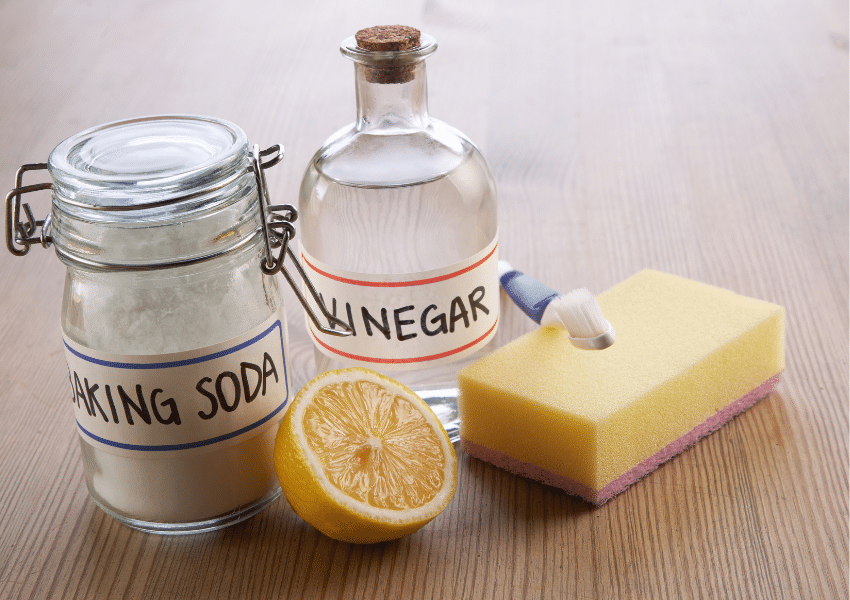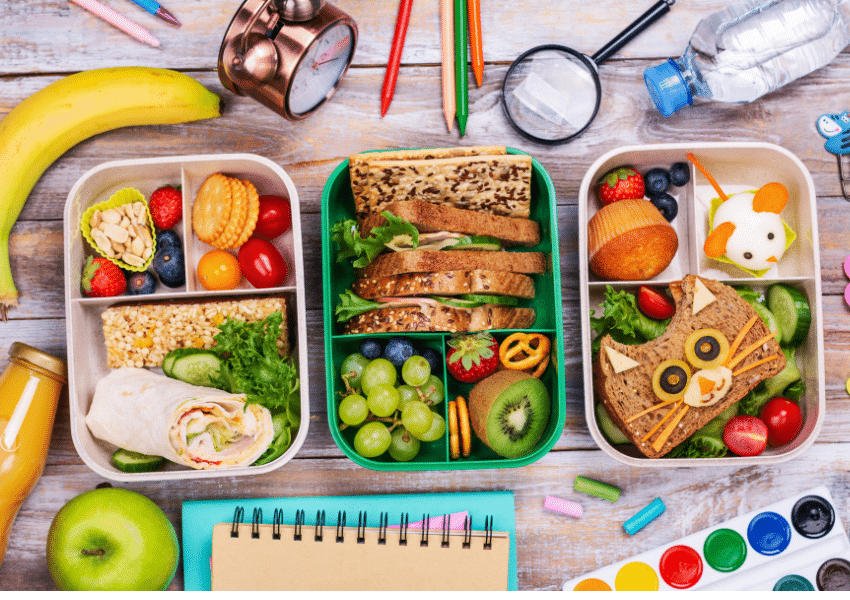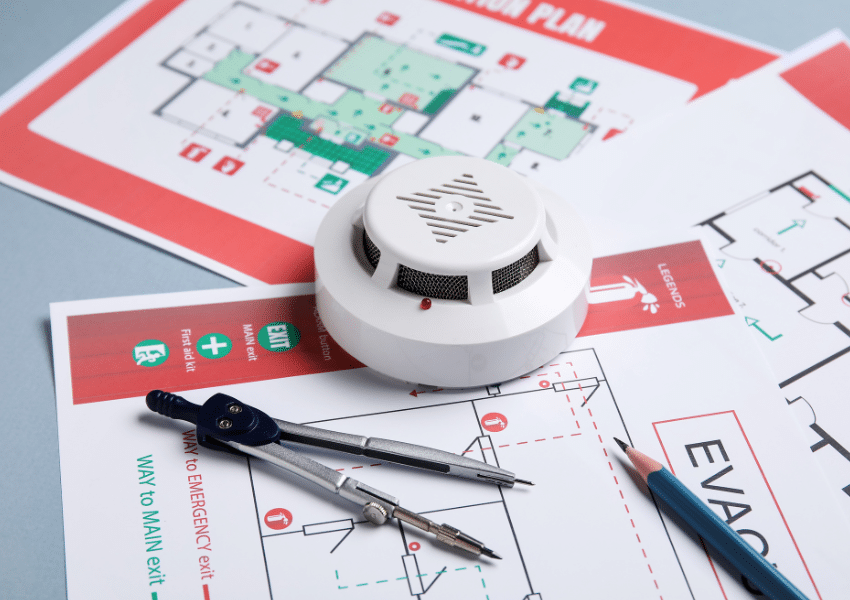
by California Casualty | Helpful Tips |
Who says cleaning has to come in a plastic bottle filled with mystery chemicals you can’t even pronounce? With a few simple pantry staples—think vinegar, baking soda, and a lemon peel—you can whip up DIY cleaning products that are safe, budget-friendly, and surprisingly powerful. Bonus: they smell a whole lot better, too.
Pantry Powerhouses: The Magic Behind DIY Cleaners
Before diving into recipes, let’s get to know a few key ingredients that make these formulas shine:
- Baking Soda: Also known as sodium bicarbonate, this kitchen staple is not just for baking—it’s a powerful cleaner, too. Its mild abrasiveness makes it great for scrubbing, while its whitening, brightening, and deodorizing properties leave surfaces fresh and clean.
- Vinegar: An all-star degreaser and deodorizer, vinegar is a fantastic cleaner for glass and nonporous surfaces. It’s acidic, so avoid using it on natural stone like granite or marble, cast iron, stainless steel and unfinished wood—as it could corrode or damage them. Never mix vinegar with bleach (or you risk a dangerous reaction).
- Citric Acid: Found naturally in citrus fruits, citric acid is sold in powder form. It is excellent at cutting grease, removing stains, and tackling mineral deposits. It’s not good for all surfaces, though. Like vinegar, it is high in acidity. Skip citric acid on wood floors, electronics, copper, brass, and natural stone.
A Note on Mixing Vinegar + Baking Soda
That fizzy foam is fun and can help lift dirt—but baking soda and vinegar neutralize each other when combined. The leftover liquid isn’t a strong cleaner. Use them separately for best results.
Tried-and-True DIY Recipes
We researched some of the most popular do-it-yourself formulas for homemade household cleaners. Do you have a favorite that’s not on this list? Be sure to share it in the comments.
All-Purpose Cleaner
- ¼ cup Dawn dish soap
- ½ cup lemon juice
- ¾ cup vinegar
- ½ cup rubbing alcohol
- 1¼ cups water
Mix the ingredients above and store in a spray bottle. Pro tip: Infuse the vinegar with lemon, orange or grapefruit peels for 1–2 weeks for a fresh scent and extra grease-cutting power.
Alternatively, you can use a simpler version of just ½ cup white vinegar and 4 cups warm water for an all-purpose cleaner. Cleaning glass? Use equal amounts vinegar and water to remove fingerprints and smudges.
Carpet Freshener
- 2 cups borax
- 1 cup baking soda
- 10 drops essential oil
Mix the ingredients above and store them in an airtight container. When you’re ready to use it, sprinkle the mixture on your carpet. Let it sit 30 minutes, then vacuum. Not only does it freshen the room, it helps repel pests and deter rodents.
Carpet Stain Remover
- Baking soda
- 1 Tbsp. Dawn dish soap
- 1 Tbsp. white vinegar
- 2 cups warm water
Sprinkle baking soda on the stain, wait 10 minutes, then vacuum. Mix the dish soap, vinegar and water, and apply with a sponge. Use a clean cloth to blot the moisture. Repeat with sponging the water mixture and blotting until the stain disappears.
Dishwasher Detergent
- 8 oz castile soap
- 1 cup water
- 3 Tbsp. vinegar
Mix ingredients together and store in an airtight container. When you are ready to run the dishwasher, add 1 tablespoon per load.
Drain Cleaner
- ½ cup borax
- ½ cup salt
- 1 cup white vinegar
Mix the above ingredients into a paste and pour it into the drain. Let it sit 30 minutes, then flush with boiling water.
Fabric Softener
- 5½ cups water
- 15 oz. hair conditioner
- 2½ cups vinegar
- 20 drops essential oil (optional especially if your hair conditioner has a nice scent)
Mix and store. Use ¼ cup per wash during the rinse cycle.
Grout Cleaner
Add water to baking soda until it forms a paste. Apply that paste to the grout. Let it sit 15 minutes, then scrub with a stiff brush and rinse with water.
Hardwood Floor Shine
- Bucket of warm water
- Few drops natural dish soap
- 1 tsp castile soap or olive oil
Mop as usual to restore the shine without damaging the wood.
Soft Scrub Cleanser
- 1½ cups baking soda
- ½ cup liquid laundry soap
- 10 drops tea tree, lavender, or lemon essential oil
Mix into a paste and store airtight. Rehydrate with water if it dries.
Toilet Bowl Cleaner
- 1 cup baking soda
- ¼ cup citric acid
- ½ cup vinegar
Mix the dry ingredients—the baking soda and citric acid. Sprinkle that powder mixture in the toilet bowl. Then, add vinegar to the bowl, which will cause it to foam. Scrub and then flush.
Cleaning and Protecting
For some additional inspiration, check out our blog on 5 Hacks for Cleaning Your House While Everyone’s Home.
Of course, taking care of your home goes beyond keeping it clean—it’s about protecting everything you’ve worked so hard for. At California Casualty, we understand your home is your greatest investment, and we’re here to make sure it’s fully protected with the right insurance coverage.
This article is furnished by California Casualty, providing auto and home insurance to educators, law enforcement officers, firefighters, and nurses. Get a quote at 1.866.704.8614 or www.calcas.com.

by California Casualty | Nurses |
When most people picture a nurse, they imagine bedside care in a hospital—checking vital signs, administering medications, and comforting patients. While that’s certainly a cornerstone of the profession, today’s nursing world is far broader and more dynamic than ever before. Nurses are branching out into unexpected environments, leveraging new technologies, and carving out specialties that align with unique passions and lifestyles.
From tending to campers in the woods to caring for patients at sea or investigating crime scenes, nursing offers an incredible variety of career paths. If you’ve ever wondered what opportunities lie beyond the hospital floor, here are some exciting and specialized roles that just might be your perfect fit.
Adventure-Filled Roles
Amusement Park Nurse
If you thrive in high-energy environments, becoming an amusement park nurse could be a thrilling fit. These nurses respond quickly to everything from bumps and bruises to medical emergencies, often acting as first responders until patients can be transported to hospitals. Documentation and assessment skills are critical, as is the ability to communicate across language and cultural barriers. Registered Nurses (RNs) with strong emergency or trauma backgrounds shine in this role.
Camp Nurse
Imagine trading fluorescent lights for fresh air and the laughter of children. Camp nurses provide care at day camps and overnight programs, handling everything from bug bites and sprains to more serious conditions. Some camps focus on children with disabilities or chronic illnesses, which requires additional vigilance and compassion. Nurses often manage the camp health office and keep detailed records. An ER, pediatric, or trauma background can prepare you well for this role.
Cruise Ship Nurse
For those with wanderlust, cruise ship nursing blends healthcare with travel. Onboard, you’ll staff both walk-in clinics for routine needs and fully equipped ERs for emergencies. You’ll treat passengers from around the world, handle acute symptoms, and sometimes navigate international laws and insurance complexities. Expect close living quarters with other crew members and lots of adventure at sea. RNs with critical care or emergency experience—and a valid passport—are in high demand.
Military Nurse
Military nurses provide care to active-duty soldiers, veterans, and their families both at home and overseas. Beyond medical expertise, this role requires resilience and adaptability, as nurses may practice in challenging environments. It’s a career that combines service to country with service to patients.
Travel Nurse
Want variety without committing to one location? Travel nurses work short-term contracts at hospitals and clinics across the country—and sometimes internationally. While the staffing agency is your official employer, your workplace can change every few months, offering endless opportunities to explore new settings. Travel nurses need to adapt quickly to different teams, technologies, and patient populations. A BSN or ADN is required, and additional certifications make you even more competitive.
Patient-Centered Specialists
Hospice Nurse
Providing end-of-life care requires both clinical expertise and deep compassion. Hospice nurses support terminally ill patients and their families, offering comfort and dignity during difficult times. While emotionally challenging, many nurses find this work profoundly rewarding. A nursing degree is required, and certification as a Certified Hospice and Palliative Nurse is available for those who wish to specialize further.
Nurse Midwife
Nurse midwives guide women through pregnancy, childbirth, and postpartum care, often forming close bonds with families. In many states, they can practice independently from physicians. This role blends advanced medical knowledge with a holistic, patient-centered approach to women’s health.
School Nurse
School nurses are vital to student health and wellness, addressing everything from playground injuries to chronic conditions like asthma and diabetes. They conduct screenings, administer medications, and play a critical role in keeping kids healthy and ready to learn. A BSN or higher is typically required. Many states require a school nursing certificate as well.
Nurse Navigator
Navigating the healthcare system can be overwhelming, especially for patients with complex conditions like cancer. Nurse navigators serve as guides—educating patients, coordinating appointments, and helping families understand treatment plans. This role requires both organizational skills and a compassionate touch.
Cutting-Edge and Innovative Roles
Forensic Nurse
Forensic nursing blends healthcare with criminal justice. These nurses care for victims of assault and abuse while also helping collect evidence and testify in court cases. They may work alongside coroners or law enforcement. A BSN is often required, and a forensic nursing certificate can open even more doors.
Home Infusion Nurse
In this role, the hospital comes to the patient. Home infusion nurses administer intravenous treatments in a patient’s home. They also educate patients and families, creating safe and supportive care environments outside of traditional settings.
Informatics Nurse
For nurses with an interest in data and technology, informatics is an exciting frontier. These professionals bridge the gap between clinical practice and IT, ensuring that health information systems support high-quality care. They analyze data, redesign workflows, and help shape the future of digital healthcare.
Nurse Auditor
Nurse auditors work behind the scenes, reviewing records to prevent fraud, waste, and abuse. They play an essential role in quality assurance and financial accuracy for healthcare organizations. If you love details and data, this career path could be a great fit.
Nurse Esthetician
Focused on beauty and wellness, nurse estheticians provide advanced skincare and cosmetic treatments like injectables, chemical peels, and laser therapies. This role requires medical expertise and a flair for artistry, making it a rewarding niche for those passionate about aesthetics.
Nursing Legal Consultant
Nurses with strong analytical skills can thrive as legal consultants, helping attorneys interpret medical records, statutes, and standards of care. They may prepare documentation, attend medical examinations, and even testify in court. An RN license is essential for this role.
Telehealth Nurse
Telehealth is one of the fastest-growing areas of nursing, allowing professionals to provide care virtually. From triaging patients to remote monitoring and care coordination, telehealth nurses can work from a variety of locations—including their own homes. This role requires excellent communication skills and comfort with technology.
Nurse Recruiter
Not all nurses provide direct care. Nurse recruiters leverage their knowledge of the profession to identify, interview, and hire qualified candidates. Many recruiters work in staffing agencies or healthcare organizations. A background in nursing, human resources, or healthcare administration is often helpful.
Wherever your nursing career may take you—whether it’s bedside, beyond the hospital walls, or across the country—California Casualty is here to help protect what matters most. For more than 100 years, we’ve been providing top-notch home and auto insurance to Community Heroes like you. It’s our policy to do more for those who give more, and that includes the dedicated nurses who care for us every day.
This article is furnished by California Casualty, providing auto and home insurance to educators, law enforcement officers, firefighters, and nurses. Get a quote at 1.866.704.8614 or www.calcas.com.

by California Casualty | Auto Insurance Info |
Your car isn’t just a way to get from point A to point B—it’s a billboard for your personality. That minivan? Probably secretly a superhero in disguise. That flashy convertible? Definitely a thrill-seeker who lives for the spotlight. Buckle up, because we’re taking a fun ride into what your vehicle really says about you.
Let’s talk color.
Think of your car’s paint job as a giant mood ring on wheels—broadcasting your vibe before you even step out. Some shades whisper, others shout, and all of them say something about who’s behind the wheel.
- Red – Bold, fiery, and impossible to ignore. A red car screams, “Look at me!” Whether it’s passion, speed, or a thirst for adventure, red drivers are all about standing out.
- Yellow & Orange – Sunny, upbeat, and just a little bit quirky. These rare road gems belong to the optimists and free spirits who aren’t afraid to zig while everyone else zags.
- Green – From eco-warrior to outdoorsy adventurer, green says you’re in tune with nature—and maybe even a little creative. Go bright for playful energy, dark for polished sophistication.
- Blue – Calm, cool, collected. Blue is the color of trust, stability, and loyalty, which is why it’s often the family favorite. Blue-car drivers give off dependable vibes—even if they do secretly speed when no one’s looking.
- Black – Sleek, powerful, and timeless. Black cars exude confidence and prestige. They can be stylishly elegant… or just a little bit intimidating.
- Silver, Gray & White – Clean, crisp, and effortlessly cool. These neutral tones say you appreciate subtlety over flash. Bonus: they hide dirt and scratches better than most—practical and polished all at once.
- Brown, Bronze, Gold & Tan – Down-to-earth and unpretentious, these colors belong to the reliable realists. Whether it’s a latte-like tan or a deep chocolate brown, you’re all about substance over show.
Now let’s talk type.
Your car’s shape says just as much as its color. From low-slung convertibles to family-friendly haulers, the body style you choose is like a personality profile on four wheels. Let’s see what your ride reveals.
The Sleek Sports Car – The Adrenaline Junkie
You’re bold, confident, and not afraid of a little attention (okay, a lot of attention). Life for you is about speed, style, and seizing the moment. Whether you’re chasing the thrill of the open road or just pulling into the coffee shop parking lot, you love to make an entrance. Friends know you as the one who’s always up for an adventure, the one who adds a little spark—and maybe a little drama—to every outing. Buckle up, because with you in the driver’s seat, life is never stuck in the slow lane.
The Practical Sedan – The Organized Achiever
Reliable, steady, and efficient—if you’re behind the wheel of a sedan, people can count on you. You’re the type who actually reads the manual (and maybe highlights it). Schedules, routines, and to-do lists? You’ve got them down to a science. Your car choice reflects your ability to get things done without unnecessary flash. But don’t mistake your practicality for boring—you know exactly what you want, and you know the smartest way to get there. In a world full of detours, you’re the one who always finds the fastest, most sensible route.
The SUV or Crossover – The Adventurer/Family Hero
SUV and crossover drivers are the ultimate multitaskers. One day, you’re hauling soccer gear; the next, you’re loaded up with hiking packs and snacks for a road trip. You thrive on versatility and love knowing you’re ready for anything—from a weekend camping trip to a Costco run. Friends see you as dependable and fun, with a “why not?” spirit that’s always game for the next big adventure. Your car says, “Hop in, there’s room for everyone,” and that’s exactly how you live your life.
The Minivan – The Secret Superhero
You may not always get the flashy spotlight, but let’s be real—you’re the one holding everything together. Minivan drivers are the unsung heroes of the road, juggling schedules, passengers, and bags of snacks with ease. You’re resourceful, patient, and always prepared for chaos (with a pack of wipes hidden in the glovebox, just in case). Behind the wheel, you’re proof that practicality is powerful, and you manage to do it all while keeping your cool. Others might underestimate you, but those who know you understand—you’re the real MVP.
The Convertible – The Free Spirit
Top down, wind in your hair—you’re all about living in the moment. Convertible drivers thrive on freedom, sunshine, and a little bit of flair. You’re spontaneous, fun-loving, and happiest when life feels like a rolling playlist of good vibes. Your car doesn’t just get you places—it turns every drive into a mini vacation. If life is a highway, you’re the one singing at the top of your lungs in the fast lane.
The Electric/Hybrid – The Thoughtful Innovator
Forward-thinking and eco-conscious, you’re not just driving—you’re making a statement. Electric and hybrid drivers care about the bigger picture, and you like to be on the cutting edge of what’s next. You’re smart, intentional, and probably have a gadget or two that makes life easier (and cooler). Your car reflects your values: sustainability, progress, and a touch of sophistication. You’re not just keeping up with the future—you’re helping shape it.
The Vintage/Classic Car – The Nostalgic Romantic
Driving a classic car isn’t just transportation—it’s an art form. You appreciate craftsmanship, character, and things that last. Nostalgic at heart, you value stories, traditions, and the beauty of a simpler time. Friends might tease you for being “old school,” but they secretly admire your sense of style and your refusal to settle for the ordinary. Like your car, you’re timeless—and you wouldn’t have it any other way.
No matter what you drive—flashy, practical, adventurous, or timeless—your car is more than just transportation. It’s part of your story, and it deserves the same care and protection you give yourself. Be sure to protect it with the right insurance coverage to safeguard against the unexpected. Safe travels.
This article is furnished by California Casualty, providing auto and home insurance to educators, law enforcement officers, firefighters, and nurses. Get a quote at 1.866.704.8614 or www.calcas.com.

by California Casualty | Health, Helpful Tips |
Packing a lunch isn’t just about sandwiches and snacks—it’s a little daily opportunity to say, “I love you.” From notes that spark giggles to colorful, kid-approved meals that secretly pack in nutrition, your child’s lunchbox can become a tiny treasure chest of connection, creativity, and fun. Let’s explore playful ideas that make lunchtime a moment to smile, bond, and maybe even start a new family tradition.
Make Presentation Part of the Fun
Children eat with their eyes first, so the way food is presented can be just as important as what you pack. A lunchbox with a little personality is more exciting and encourages kids to try different foods.
- Cookie cutters for fun shapes: Cut sandwiches, cheese, or melon into stars, hearts, or animals. Even picky eaters are more likely to nibble on something shaped like a dinosaur.
- Bento-style compartments: Separate each item into neat sections. Not only does this make food look appealing, but it also prevents flavors from mingling (a lifesaver for kids who don’t want their carrots touching their crackers).
- Silicone baking cups: Bright and reusable, these cups help organize food and add a pop of color.
- Food on skewers: For older children, try non-sharp skewers or toothpicks to make fruit kebabs, veggie stacks, or mini sandwich bites. They feel like party food!
- A rainbow of colors: Add natural vibrancy with strawberries, blueberries, carrots, cucumbers, and yellow peppers. A colorful plate looks more appetizing and signals variety.
- Kid-friendly packaging: Avoid items that are difficult to open. A lunchbox should be a moment of joy, not frustration.
Tip: Pack bite-sized portions that engage all the senses—something crunchy, something smooth, something juicy, and contrasting textures like apple slices with cheese cubes.
Healthy Meals Kids Actually Want to Eat
Nutritious doesn’t have to mean boring. The key is balancing wholesome ingredients with kid-approved flavors. Here are some ideas that bridge both worlds:
- Pinwheel wraps: Spread hummus or cream cheese on a tortilla, layer with veggies or deli meat, roll it up, and slice into colorful rounds.
- Sandwiches with personality: Add banana “eyes” with blueberry pupils to a peanut butter and jelly sandwich. Try a carrot “nose” and a red pepper “smile” for a cheese sandwich. Hold them in place with a dab of cream cheese or peanut butter. Your child won’t forget the day their sandwich grinned at them.
- Stuffed pitas: Fill with lean protein and crunchy veggies for a handheld meal that feels different from the usual sandwich.
- Mini charcuterie board: Cheese cubes, crackers, rolled turkey slices, grapes, and pretzels. It’s snacky, customizable, and fun to assemble.
- Veggies and dip: Pair carrots, celery, or snap peas with hummus, guacamole, or ranch for dipping.
- Mini muffins: Bake ahead with fruit or shredded zucchini and carrots. They feel like a treat but sneak in extra nutrition.
- Yogurt parfaits: Layer yogurt, fruit, and granola in a small container for a colorful surprise.
- Mini bagels: Spread with cream cheese, nut butter, or avocado for a satisfying bite.
- Pasta salad: Toss whole-grain pasta with veggies, cheese, and a drizzle of dressing for a hearty option.
Tip: Involve your kids in the process: create a list of “parent-approved choices” and let them pick their favorites for the week. When children help pack their own lunches, they’re more likely to eat and enjoy them.
Jokes, Puns, and Motivational Messages
Lunchtime is a great time to connect with kids may be tired, missing home, or needing a boost of encouragement. A short note tucked into the lunchbox can do wonders. Kids love humor, and a silly joke can turn an ordinary lunch into a giggle break. Or maybe your child would love a pep talk before that big spelling test.
Jokes
Fold the paper so the joke is on the outside and the punchline is hidden inside. Here are some of our favorites.
Who is the king of the pencil case? The ruler.
- What did the ice say to the water? I’m cooler than you.
- What did the paper say to the pen? You have a good point.
Puns
As kids expand their language skills, they find delight in word play. Here are some food-inspired puns you can try.
Orange you glad it’s lunch time?
- Donut forget how awesome you are.
- Lettuce celebrate how great you are.
Motivational Messages
Kids of all ages appreciate messages of support. Share a favorite quote or saying that says you’ve got this.
If kids were flowers, I’d pick you every time.
- Today is a great day to learn something new.
- “The future belongs to those who believe in the beauty of their dreams.” – Eleanor Roosevelt
And More…
- Keep it short and sweet: A sentence or two is enough.
- Use color: Bright pens, stickers, or doodles make your message stand out.
- Think outside the paper: Write on a cupcake wrapper, a disposable container or on the outside of a banana.
- Try a game to make it interactive. Draw a simple maze or a word search. Just make sure to include a crayon.
Tip: To save time, write a batch of notes in advance. That way, when mornings get hectic (as they often do), you can simply slip one in.
Make It a Family Tradition
Lunchbox love doesn’t have to be just for the little ones. As kids grow, the ways you connect can evolve. Maybe your middle schooler prefers a thoughtful quote, or your high schooler enjoys a funny meme tucked in with their lunch. The point is the same: you’re reminding them that you care.
So, the next time you’re packing a lunch, think of it not as a chore but as a chance to sprinkle in a little joy. After all, love is the most important ingredient you can pack.
This article is furnished by California Casualty, providing auto and home insurance to educators, law enforcement officers, firefighters, and nurses. Get a quote at 1.866.704.8614 or www.calcas.com.

by California Casualty | Helpful Tips, Homeowners Insurance Info, Safety |
When fire breaks out, every second counts. Knowing exactly what to do—and what to avoid—can mean the difference between safety and tragedy. Whether you’re at home, at work, or out in public, understanding how to respond in a fire emergency gives you the power to act quickly, protect loved ones, and make it out safely.
Understanding the Phases of a Fire
Before you can respond effectively, it helps to understand how a fire behaves. Fires move through distinct phases, though the timing can vary depending on what is burning and where the fire occurs:
- Incipient Phase – This is the very beginning, when the fire first ignites. If detected quickly, it may still be possible to put it out safely with the right tools.
- Growth Phase – Flames spread, heat builds rapidly, and conditions begin to change. This is when a small fire can suddenly get out of control.
- Fully Developed Phase – At its peak intensity, a fire consumes all available fuel, producing thick smoke and toxic gases. Escape is the only safe option.
- Decay Phase – As the fire runs out of fuel, flames and heat decrease, but smoke and gases can still be dangerous.
What to Do in a Fire Emergency
When you encounter fire, your actions need to be quick, calm, and deliberate. Here are the key “Do’s” to remember:
1. Act Early if It’s Safe
If you catch the fire in its earliest stage (the incipient phase), and you have the right type of extinguisher, you may be able to stop it from spreading. Always aim the extinguisher at the base of the flames, not the middle or top.
In the kitchen:
- Turn off the heat source.
- Smother small stovetop flames with a metal lid, baking sheet, or fire blanket.
- Use baking soda or salt on grease fires—but never water or flour.
- Follow these tips for other ways to put out a fire.
- If a fire starts inside your oven or microwave, keep the door closed. The lack of oxygen will usually cause the fire to die down.
If the fire is spreading quickly, do not try to fight it. Get out immediately and call 911.
2. Get to Safety
Plan for at least two exits from every room in your home. Fires often make the most obvious path unusable. Heavy smoke can quickly disorient you, so it helps to know the layout of your home by memory. Practice fire drills with your family so that everyone knows how to react without hesitation.
3. Stay Low
Smoke rises and carries carbon monoxide, which can make you dizzy or even cause unconsciousness. Crawling low to the ground gives you cleaner air to breathe and increases your chance of escape.
4. Stop, Drop, and Roll
If your clothing catches fire, don’t run. Running only fuels the flames. Instead, stop, drop to the ground, and roll back and forth while covering your face. This smothers the flames and helps prevent serious injury.
5. If You’re Trapped
Sometimes escape isn’t possible. If you can’t get out:
- Stay away from doors that are hot to the touch.
- Block smoke by placing wet towels or blankets along the bottom of doors.
- Open windows cautiously, crouching down to avoid rising smoke and heat.
- Signal for help by waving a flashlight or cloth out the window.
What NOT to Do in a Fire Emergency
Just as important as knowing what to do is knowing what not to do. Certain instinctive reactions can actually make things worse:
- Don’t use elevators. Fires can cause electrical failures or trap you inside. Always use the stairs.
- Don’t pour water on grease fires. Water splashes burning oil and creates explosive steam.
- Don’t pour flour on a fire. Flour is combustible. Stick with baking soda, salt, or a fire extinguisher.
- Don’t use water on electrical fires. Water conducts electricity and can cause electrocution.
- Don’t fan flames. Adding oxygen only makes a fire grow.
- Don’t stand too close or reach over flames. Loose clothing can ignite quickly.
- Don’t move burning objects. This can spread flames to new areas.
- Don’t aim a fire extinguisher at the flames themselves. Remember: always target the base of the fire.
Preparing Before a Fire Happens
While these tips can help in the moment, preparation is your best defense. Here’s how to protect yourself and your loved ones:
- Install smoke alarms on every level of your home, especially near bedrooms. Test smoke detectors monthly and replace batteries at least once a year.
- Create and practice a fire escape plan with your household. Make sure every member—children included—knows how to get out and where to meet once outside.
- Keep fire extinguishers accessible. Place them in the kitchen, garage, and near exits. Learn how to use them before an emergency arises.
- Understand the common causes of fires so you can take steps to fireproof your home and minimize these risks.
- Know your insurance coverage. Even when you do everything right, fires happen. Having the right coverage can make the recovery process easier and less stressful.
This article is furnished by California Casualty, providing auto and home insurance to educators, law enforcement officers, firefighters, and nurses. Get a quote at 1.866.704.8614 or www.calcas.com.





